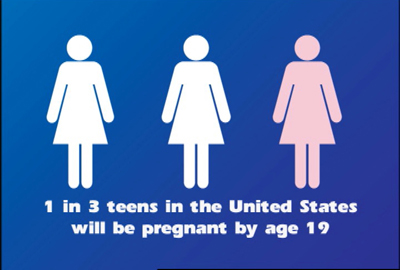Teen Pregnancy Statistics and Teen Pregnancy Facts
The United States has the highest rates of teen pregnancy and births in the western industrialized world. Teen pregnancy costs the United States at least $7 billion annually.
Thirty-four percent of young women become pregnant at least once before they reach the age of 20 — about 820,000 a year. Eight in ten of these teen pregnancies are unintended and 79 percent are to unmarried teens.
The teen birth rate has declined slowly but steadily from 1991 to 2002 with an overall decline of 30 percent for those aged 15 to 19. These recent declines reverse the 23-percent rise in the teenage birth rate from 1986 to 1991. The largest decline since 1991 by race was for black women. The birth rate for black teens aged 15 to 19 fell 42 percent between 1991 to 2002. Hispanic teen birth rates declined 20 percent between 1991 and 2002. The rates of both Hispanics and blacks, however, remain higher than for other groups. Hispanic teens now have the highest teenage birth rates. Most teenagers giving birth before 1980 were married whereas most teens giving birth today are unmarried.
The younger a teenaged girl is when she has sex for the first time, the more likely she is to have had unwanted or non-voluntary sex. Close to four in ten girls who had first intercourse at 13 or 14 report it was either non-voluntary or unwanted.
Teenage Pregnancy Consequences
Teen mothers are less likely to complete high school (only one-third receive a high school diploma) and only 1.5% have a college degree by age 30. Teen mothers are more likely to end up on welfare (nearly 80 percent of unmarried teen mothers end up on welfare).
The children of teenage mothers have lower birth weights, are more likely to perform poorly in school, and are at greater risk of abuse and neglect.
The sons of teen mothers are 13 percent more likely to end up in prison while teen daughters are 22 percent more likely to become teen mothers themselves.
Teen Pregnancy Prevention
The primary reason that teenage girls who have never had intercourse give for abstaining from sex is that having sex would be against their religious or moral values. Other reasons cited include desire to avoid pregnancy, fear of contracting a sexually transmitted disease (STD), and not having met the appropriate partner. Three of four girls and over half of boys report that girls who have sex do so because their boyfriends want them to.
Teenagers who have strong emotional attachments to their parents are much less likely to become sexually active at an early age and less likely to have a teen pregnancy.
Most people say teens should remain abstinent but should have access to contraception. Ninety-four percent of adults in the United States-and 91 percent of teenagers-think it important that school-aged children and teenagers be given a strong message from society that they should abstain from sex until they are out of high school. Seventy-eight percent of adults also think that sexually active teenagers should have access to contraception to prevent teen pregnancy.
Contraceptive use among sexually active teens has increased but remains inconsistent. Three-quarters of teens use some method of contraception (usually a condom) the first time they have sex. A sexually active teen who does not use contraception has a 90 percent chance of teen pregnancy within one year.
Parents rate high among many adolescents as trustworthy and preferred information sources on birth control. One in two teens say they “trust” their parents most for reliable and complete information about birth control, only 12 percent say a friend.
Teens who have been raised by both parents (biological or adoptive) from birth, have lower probabilities of having sex than youths who grew up in any other family situation. At age 16, 22 percent of girls from intact families and 44 percent of other girls have had sex at least once. Similarly, teens from intact, two-parent families are less likely to give birth in their teens than girls from other family backgrounds.
Teen Pregnancy information obtained from The National Campaign To Prevent Teen Pregnancy
